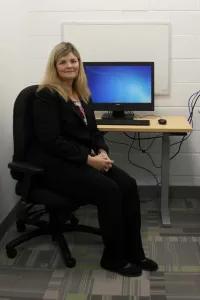
All Access: UTM's new test and exam centre accommodates growing demand for accessible space
As students at U of T Mississauga sharpen their pencils for the exam period, a new centre is accommodating a growing number of students who need alternate spaces to write tests and exams. The new AccessAbility Test and Exam Centre officially opened in October 2016 in its new location in DV 1100.
Previously, students requiring accommodations wrote in makeshift spaces in the Student Centre and, more recently, cramped office spaces in the North Building. Demolition of the North Building prompted a move to the new location—a fully renovated space beside a quiet hallway in the Davis building. The new centre boasts 20 private writing rooms, doubling the number of spaces previously available. The rooms are also larger than their predecessors, and can accommodate mobility scooters, wheelchairs, service dogs or students using the services of a human scribe or reader. The rooms also feature adjustable lighting and noise-masking system to cut down on auditory distractions. Upgraded technology includes new computers with assisted soft ware programs, including speech-to-text and screen magnification.
Last year, 4,767 tests and exams were coordinated and supervised by AccessAbility Services and, according to AccessAbility Resource Centre director Elizabeth Martin, the demand for services is growing. The number of students requiring accommodations has jumped 25 per cent, from 651 students in the 2014-2015 academic year, to 812 students in 2015-2016 academic year. “This December, we are facilitating 400 more test and exams than we did last December,” Martin says.
Martin says some of the demand is the result of an increasing number of students identified with learning disabilities at the high school level, but notes that there are other factors, too. “Over the past five years, we’ve seen a lot of growth in service demand, especially for mental health and autism supports,” she says. “University students are in the age demographic where many mental health issues begin to present symptoms.”
Martin works with four other AccessAbility advisors who meet with students to assess challenges and determine which supports might be beneficial to them. “We have good partnerships with the Health and Counselling Centre, as well as faculty who might see when a student is having challenges,” she says. “We work with students that have a number of disabilities, including blind and low vision students, deaf and hard of hearing students, autism and learning disabilities and attention deficit disorder or acquired brain injuries, such as concussions. We also assist students with temporary disabilities, such a broken dominant arm, or who have missed school due to surgery.”
